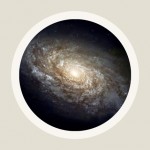Dictionary
Hubble constant
In an expanding universe such as that of the big bang models, every observer will find: The apparent velocity with which the galaxies around him recede is proportional to their distance; the more distant a galaxy, the more its distance increases in a given time. This relation was first found by the astronomer Edwin Hubble in the 1920s from observations of far-away galaxies; it is hence called Hubble relation or Hubble’s law, and the constant of proportionality between speed and distance is the Hubble constant.
A visualisation of the Hubble relation can be found on the page The expanding universe in the chapter on Cosmology of Elementary Einstein.
The Hubble relation only holds for all galaxies in an idealized universe whose expansion neither accelerates nor slows down. In more realistic universes, it is true in good approximation only for galaxies that are not too far away.









